Architecture
Architecture
The architecture of a place is often a tourist attraction in its own right. Many buildings are quite beautiful to look at and the view from a tall building or from a cleverly-positioned window can be a beauty to behold. Architecture overlaps considerably with other fields including urban planning, civil engineering, decorative arts, interior design and landscape design.
 Some of the finest examples of architecture are almost fractally interesting — there is something worth a look whatever scale you choose. From a meter away, the impressive thing about the Taj Mahal is the fine stone inlay work on many surfaces. At a few meters, the elegant shapes of various things draw the eye. Moving further back, one sees the building as a whole and the extensive gardens. To fully understand the Taj, one would need to look at the history of the Mughal Empire and the traditions of Islamic art. Someone looking at a Frank Lloyd Wright house might consider anything from what it would be like to cook in that kitchen to how the place fits into its neighbourhood.
Some of the finest examples of architecture are almost fractally interesting — there is something worth a look whatever scale you choose. From a meter away, the impressive thing about the Taj Mahal is the fine stone inlay work on many surfaces. At a few meters, the elegant shapes of various things draw the eye. Moving further back, one sees the building as a whole and the extensive gardens. To fully understand the Taj, one would need to look at the history of the Mughal Empire and the traditions of Islamic art. Someone looking at a Frank Lloyd Wright house might consider anything from what it would be like to cook in that kitchen to how the place fits into its neighbourhood.
Many examples of fine architecture are on the UNESCO World Heritage List. They also have a World Heritage Earthen Architecture Programme (WHEAP) and their Intangible Cultural Heritage list includes things like Japanese wooden buildings and various nomadic shelters such as yurts.
Understand
Historic buildings often tell their own story and provide a place with a heritage that asks the visitor to find out more. While architecture used to be limited by the styles and tastes of the area it was built in and even more the locally available material, the widespread adoption of concrete, glass and steel as well as an international exchange of architectural ideas have led to a new "global" style that is loved and hated in almost equal measure.
Urban planning
Large-scale urban planning has existed since ancient times; the Roman Empire and Imperial China practised it extensively and Ancient Egypt had pre-planned settlements built to strict specs. Priene in Ancient Greece has been called the first orthogonal-grid planned city, about 350 BCE, though Mohenjo-daro in what is now Pakistan had a grid, and the world's first municipal sewer system, about 2600 BCE. However, most settlements grew organically with little or no planning apparent to the modern observer (see old towns); cities in Medieval Europe were usually dominated by fortifications or religious buildings. This in turn led to road networks that had to follow (usually round) city walls and further considerations for the river that flowed to most cities. Still, there were some "zoning" regulations, as smelly and flammable industries such as tanners and metal smelters had to stay outside the city walls and downwind from the city, and the executioner and other "unclean" jobs likewise having to live outside the city walls.
Many colonial settlements have a rectangular grid emerging from a central plaza and a main street. There are examples all over the Americas, and in other colonies such as Macau or almost any Philippine town. Often the central plaza will have a historic church or in the more important cities, a cathedral. In many places, planned colonial development took place next to an existing older city; New Delhi outside the ancient city of Delhi, the International Settlement in Shanghai next to the old Chinese city, and so on.
Many capital cities were built specifically to play that role and were carefully planned, often by famous architects:
- Washington, D.C., designed by Pierre Charles L'Enfant in the 1790s. L'Enfant was a French military engineer who had worked with George Washington during the American Revolution.
- Canberra was built starting in 1913 to serve as Australia's capital. The husband-wife team of American architects Walter Burley Griffin and Marion Mahoney Griffin won an international design contest to become the planners. They moved to Australia to help supervise construction.
- Chandigarh was built after India achieved independence in 1947, and serves as the capital of two states, Punjab and Haryana. Le Corbusier is generally credited for the design, though several other architects played important roles.
- Brasília was built from scratch, starting in 1956, to serve as the capital of Brazil; Lúcio Costa was the master planner.
- Islamabad was built from scratch to be the capital of Pakistan, succeeding Rawalpindi in that role in 1967.
- Abuja was purpose-built to be the capital of Nigeria, taking over that role from its largest city Lagos in 1991.
- Naypyidaw was built from scratch to be the capital of Myanmar, succeeding the former capital Yangon in that role in 2005.
- Nusantara in East Kalimantan is being built from scratch to succeed Jakarta as the capital of Indonesia. Construction is scheduled to be completed by 2024. In the 19th century, steam power brought industrialization and railroads, which required large-scale city plans. In the 20th century, public transportation and the automobile allowed for suburban planning. Many suburbs or satellite towns are entirely or partly planned communities. Examples include:
- Milton Keynes, north of London
- Kanata. Ottawa is surrounded by a Green Belt where almost no development is allowed. This was the first and most successful new town just outside that belt.
Some planned areas are enclaves within larger and perhaps more chaotic cities. For example, in Metro Manila a rather large swath of land in a good location became available when an American air base was shut down. It became Bonifacio Global City which has a lot of upmarket residential, office and commercial development. Today it is the country's main hub for hi-tech; there are many call centers and several large international tech companies have their main Philippine office there.
 Then there are things like the transformation of Pudong in Shanghai. Undeveloped, suburban, mostly residential and industrial but partly agricultural in 1990, within a decade it became a major business and finance hub with many new buildings. Today it has more skyscrapers than New York City including four over 400 m (1320 ft, a quarter mile). This site has stunning photos showing the contrast, and an interesting critique of the urban design.
Then there are things like the transformation of Pudong in Shanghai. Undeveloped, suburban, mostly residential and industrial but partly agricultural in 1990, within a decade it became a major business and finance hub with many new buildings. Today it has more skyscrapers than New York City including four over 400 m (1320 ft, a quarter mile). This site has stunning photos showing the contrast, and an interesting critique of the urban design.
Other Chinese special economic zones have also undergone rapid development, much of it planned. In 1978, Shenzhen (next to Hong Kong) and Zhuhai (next to Macau) were groups of fishing villages, with a population of a few hundred thousand each; in a few years, both were bustling modern cities. In 2021, Shenzhen's population is about 12.5 million and Zhuhai is approaching two million; both are still growing. Other countries also have rapid development in areas where their governments promote it.
The fate of virtually all cities laid out according to some "master plan" is that they eventually deviate from that plan. Either because the city grows beyond the "end of the map" of that original plan (in the case of medieval European cities - growing beyond the erstwhile city walls) or, more controversially, because the plan and the needs of residents clash. Especially in the case of 19th and 20th century ideologically driven planned cities, it soon became apparent that they might look nice on a map or serve the ideas of the planners (or their bosses) but were terrible at being cities for everyday people to live in. So the master plan and the needs of the people (or sometimes geographical factors) are in conflict and often give rise to more or less workable "compromises" between the two.
Buildings by purpose
Religious buildings
See also: Religion and spirituality
Cathedrals, temples and other places of worship have, until modern times, been among the most notable and longest lasting forms of architecture, usually dominating their city or village.
Some buildings have been centers of worship for two or more religions.
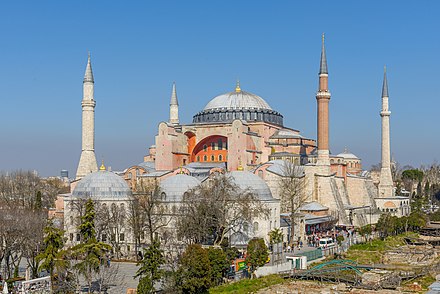
- Hagia Sophia was built as an Eastern Orthodox cathedral in Constantinople in 537 CE, during the late stages of the Roman Empire, and it served as an Orthodox church for centuries. Crusaders turned it into a Roman Catholic church, but that lasted only 1204-1261. When the Ottoman Empire took over in the 1450s, the city became Istanbul, and the church was converted to a mosque. It was a museum for nearly a century from Mustafa Kemal Atatürk's takeover until Erdoğan's 2020 decision to make it a mosque again. Some frescoes that date back to its time as a church were uncovered during restoration works during its time as a museum, and can be seen today; these are usually covered up with curtains during prayer times.
- The Great Umayyad Mosque of Damascus, the first monumental mosque in history, started out as a local deity's shrine rebuilt as a Roman temple of Jupiter, which became a church dedicated to St. John the Baptist housing his relics (to this day, they're still there, inside a gilded marble shrine). Its overhaul into the Umayyad monument, from 706 to 715 AD, is reported to have employed 200 skilled Byzantine decoration craftsmen, architects, stonemasons and mosaicists, sent by emperor Justinian II at the personal request of Umayyad caliph al-Walid.
- The Mosque–Cathedral of Córdoba was built as a mosque under the rule of the Umayyad Caliphate in A.D. 786. Following the Reconquista by the Kingdom of Castille, the mosque was converted into a Roman Catholic cathedral by the victorious Catholic monarch in 1236, and its minaret was converted to a bell tower. Nevertheless, many architectural elements dating back to its time as a mosque survive, including the former mihrab, the niche in the wall that indicates the direction of the Kaaba in Mecca.
Christian buildings
See also Christianity, Gothic architecture, Longobard sites, Wooden tserkvas of the Carpathian region
Perhaps the most well known architectural styles for churches are "Gothic" and the subsequent Renaissance style. Many Gothic cathedrals took generations or even centuries to build. The Cologne Cathedral for instance was started in the Middle Ages and not finished until the 19th century and today work to conserve and restore dilapidated parts is again ongoing.
- Basilique de Saint-Denis north of Paris
- Cathedrals of Reims and Chartres Prior to the Gothic style the Romanesque style was prevalent in much of Europe. This style is distinguished by its thick walls and heavy round arches that sharply contrast with the more filigrane pointy arches of the Gothic style. While "Gothic" was invented as a slur by opponents of the style, a revival occurred in the nineteenth century and even many US cities now have Gothic houses of worship.
In areas where stone of an appropriate quality was hard or impossible to come by a unique "Brick Gothic" style developed that is especially prevalent in Northern Germany and other areas of the former Hanseatic League. One of the most notable ensembles of buildings of that style is found in Lübeck.
Many areas that were colonized by European powers, especially the Catholic powers, also have fine cathedrals. One of Macau's best-known sights is the ruins of a cathedral, the Philippines has several, and there are examples all over Latin America.
Islamic buildings
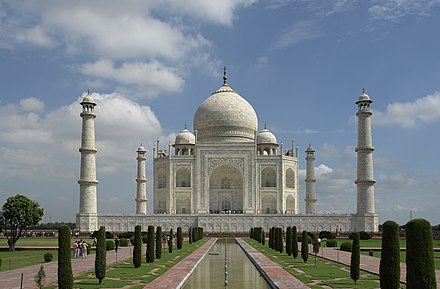
See also Islam
- Masjid al-Haram in Mecca, the place all Muslims face toward during prayer and the main destination for the Hajj pilgrimage
- Dome of the Rock/Masjid Al Sakhrah in Jerusalem
- The ancient Silk Road ran through mainly Muslim territory and there are fine mosques all along it.
- The many mosques built in the Indian subcontinent under the Mughal Empire
- The Mughal masterpiece, the Taj Mahal, which is both a tomb and a mosque
Synagogues
See also: Judaism
- Dohány Street Synagogue in Budapest, the largest in Europe
- Jakab and Komor Square Synagogue in Subotica, second largest in Europe, and a notable example of an Art Nouveau synagogue
- Prague's Old New Synagogue (in the Josefov quarter) is Europe's and probably the world's oldest synagogue in continuous use
Buildings of South Asian religions
 See also: Buddhism
See also: Buddhism
- Angkor Wat, originally a temple of the Hindu god Vishnu
- Borobudur, a Buddhist stupa and temple complex in Central Java, Indonesia dating from the 8th century, one of world's truly great ancient monuments, the single largest Buddhist structure anywhere on Earth.
- Bodh Gaya, the site where Shakyamuni Buddha is said to have gained enlightenment. It has monasteries for several Buddhist sects, including some from as far as Korea and Japan.
- The Great Stupa of Bodhnath, Kathmandu - the heart of Vajrayana Buddhism in Nepal.
Buildings of other religions
- The many pagan temples of Ancient Greece and the Roman Empire
- Manichaeism started around 250 CE in Persia and at its peak around 500 was quite widespread, but it was gone by around 1400. The only surviving temple is in Jinjiang, a suburb of Quanzhou. Quanzhou was one of the great ports of the Maritime Silk Road and has many other religious structures.
- The Maya and other civilisations in Central America such as the Aztecs built many temples
- Machu Picchu and other sites in Peru have Incan temples
Civic buildings
.jpg/440px-Big_Ben_%2B_Parlamento_(1880081856).jpg) There are a large number of buildings for civic or governmental purposes. These include:
There are a large number of buildings for civic or governmental purposes. These include:
- Seats of government in the case of (former) "merchant Republics" like the members of the Hanseatic League even (former) seats of municipal government can be impressive as they were designed to show off wealth
- Legislative buildings
- Buildings for the legal system, including courthouses and prisons; see history of justice
- In general anything representing a country or city can be designed to make an architectural statement; sometimes a (building near a) border crossing will be more opulent and impressive than strictly necessary for its utilitarian purposes; court buildings will often be adorned with statues of Iustitia, the Roman goddess/representation of justice and may be intended as "palaces of justice"
- Fortifications and other military buildings
- Grand houses, castles and other leaders' residences; see also monarchies
- Museum buildings can be interesting artifacts in their own right
- Official residences of the heads of state and/or heads of government
Industrial buildings
See also: Industrial tourism
While specialized manufacturing has been going on since the dawn of mankind, it was the Industrial Revolution from the 18th century that made industrial buildings dominate their surroundings.
While industrial buildings tend to be shaped by their function, some of them are marvels of architecture.
Transport infrastructure
 Railway stations of the 19th century have been likened to cathedrals and some historians argue that the rising bourgeoisie built them as architectural statements for the ages similar to how medieval cities built cathedrals. There is a dearth of architecturally remarkable stations during the 20th century, but the 21st century has seen a number of impressive representative buildings for new or improved transportation services.
Railway stations of the 19th century have been likened to cathedrals and some historians argue that the rising bourgeoisie built them as architectural statements for the ages similar to how medieval cities built cathedrals. There is a dearth of architecturally remarkable stations during the 20th century, but the 21st century has seen a number of impressive representative buildings for new or improved transportation services.
-
Transportation centers such as railway stations and airports; in some cases even something as seemingly commonplace as a public transport station has been designed as an architectural statement. See also travel for rail enthusiasts and urban rail adventures.
- Many newer airport terminal buildings are designed by celebrity architects to be aesthetically pleasing, and are often worth making the trip to have a look even if you are not flying. Some notable examples include Terminal 4 of Madrid-Barajas Airport, Terminal 3 of Beijing Capital International Airport, and both terminal buildings of Incheon International Airport.
-
Urban rail systems often have stations designed in various eras according to the style then en vogue. The Paris Metro is particularly noteworthy for its station design, but the Berlin U-Bahn, with "house architect" Alfred Grenander (who was actually Swedish and died in 1931), has a few impressive stations as well, and after a period of budget dictating design choices, is again taking aesthetic considerations into account for the new stations of U5. Washington DC Metro is widely considered the most beautiful example of Brutalism, and even people who otherwise despise that style acknowledge its aesthetic value there. Moscow, London, and Stockholm also have stations with significant architectural merit both above and below ground.
Memorials
Around the world, commemorative structures are amongst the most notable tourist attractions. They can be well-known feats of visual arts.
Monuments usually reflect the values of the patron and the artist no less than the commemorated person or event. Many were erected as propaganda pieces, to consolidate a ruler's cult of personality or a government's worldview, religion or ideology. Some of them become controversial over time, and a few have been moved or dismantled when posterity sees them as too provocative.
For example:
- Tombs
- The burial mounds of some prehistoric groups; see archaeology
- Egyptian pyramids, and later Egyptian tombs in the Valley of the Kings
- Chinese tombs, including the first Qin Emperor's tomb with the Terracotta Warriors
- The Taj Mahal in Agra, tomb of an Emperor's wife
- Military monuments; see military tourism
- Many capital cities around the world have a War Memorial or a Tomb of the Unknown Soldier
- Spomeniks of Yugoslavia
Periods and styles
Many architectural periods are constructed by posterity, and some architects and buildings can be difficult to periodize. Many architectural styles have experienced revivalism, becoming widespread during some decades, long after its heyday.
Ancient buildings
See also: Archaeological sites
- Stonehenge
- Pyramids in many places, most notably the great Egyptian pyramids at Giza
- The Egyptian temples of Karnak, Luxor (in the eponymous city) and Abu Simbel
- The Parthenon in Athens
- The Great Wall of China
- Remnants of the Roman Empire throughout Europe, Western Asia and North Africa. Architectural feats of the Roman Empire remain impressive for their longevity if nothing else. Many feats of civil engineering were only reached again in the industrial revolution surpassed in the 19th century or even later. The Romans used concrete and built bridges and dug tunnels that stood the test of time. Later generations even mistook those accomplishments for superhuman feats, as seen in names like "Devil's Wall" for the Limes Sarmatiae in Budapest. Some of the most notable sites are:
: The Pantheon in Rome - best preserved Roman temple anywhere, oldest important building in the world with its original roof intact - a dome with a revolutionary design for its time (which remains the record holder for the biggest unreinforced concrete dome in the world), probably designed by emperor Hadrian; widely claimed as THE ultimate architectural masterpiece of all time. : The Pont Du Gard aqueduct near Nîmes : Theaters at Orange and Taormina : Amphitheaters at Verona, Pula and El Jem : Tyre Hippodrome
Subsequent historic styles
- Islamic architecture; see also Islamic Golden Age
- Gothic architecture of Medieval Europe
- Renaissance architecture
- Baroque architecture
- Rococo architecture
- Mughal architecture
- Neoclassical architecture
In Latin America, Spanish architecture (which itself was considerably influenced by Arab styles during the Muslim rule over parts of Iberia) was adapted to local conditions and combined with native ideas to create the "colonial" style still evident in cities like Granada and León, both in Nicaragua.
European architectural styles tend to have the same periodization as European art.
Modern buildings
See also: Le Corbusier World Heritage
The phrase "modern architecture" could describe any buildings that are relatively new, but in the history of architecture it describes a specific style ("modernist architecture") marked by industrial construction methods as well as modernist philosophy featuring the functionalist, universalist and minimalist ideals that grew out of early 20th century thought. Many places defined by some of the modern and contemporary architectural styles attract tourists to visit.
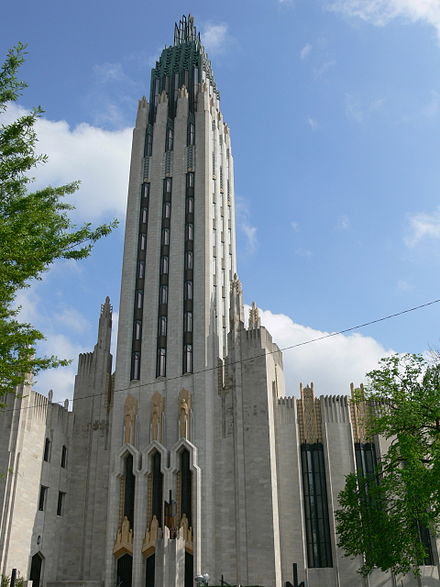
- Art Deco architecture was a style of the early 20th century which preceded modernism. In contrast to modernism, it included rich ornamentation and referenced neo-classical architecture, with columns, reliefs, and other elements similar to Graeco-Roman classicism.
- The city of Napier, New Zealand, is largely built in the Art Deco style after the town was rebuilt in the 1930s following an earthquake. The local historical society has capitalised on this and runs frequent walking tours around the buildings.
- Shanghai also has many Art Deco buildings.
- Bauhaus, a form-follows-function architectural school developed in Weimar Germany; due to exiles emigrating to the U.S, it later came to heavily influence the "international style"
- De Stijl was a modernist movement in the Netherlands for visual art, interior design and architecture.
- Functionalism is the principle that manufactured products, including buildings and furniture, should be designed for function, avoiding ornamentation and historical references. It became a style in its own right, as well as a founding principle of other modernist movements.
- International Style was a style that emerged in 1920s Western Europe and became ubiquitous around the world up to the 1970s.
- Brutalism is a mid-20th century style, that descended from the modernist movement, known for exposure of load-bearing beams and utilities such as plumbing. Steel and concrete are preferred materials, without paint, plaster or other coverings.
- Stalinist architecture was based on Neoclassical architecture, with some influences from Art Deco and Bauhaus, popular in the Soviet Union and the rest of the Eastern Bloc up till the 1950s
- Post-modernism was the style that challenged modernism in the second half of the 20th century, with an eclectic mixture of ornaments and other details.
Other 20th century movements that challenged modernism were historicism with revival of older styles, and critical regionalism with revival of local materials and aesthetics to reclaim local identity.
With the rise of the automobile, novelty architecture has been used as a means of roadside promotion. Examples would include restaurants shaped like oversized oranges or motels in which each room is a railway caboose or a concrete wigwam.
Vernacular buildings
Vernacular architecture or folk architecture includes homes, farms and workplaces for common people. They tend to use local designs and materials. While these buildings had lower status than institutional buildings, they are today valuable artifacts which give an idea about pre-modern society. Some of them are preserved or reconstructed in open-air museums.
Well-known architects
There have been many famous architects over the centuries. We list some here in chronological order by date of birth.
Imhotep
 The chancellor to the Egyptian Pharaoh Djoser (4th Dynasty, about 2600 BC) was probably the architect of Djoser's step pyramid at Saqqara, as well as a physician and high priest of the sun god Ra at Heliopolis.
The chancellor to the Egyptian Pharaoh Djoser (4th Dynasty, about 2600 BC) was probably the architect of Djoser's step pyramid at Saqqara, as well as a physician and high priest of the sun god Ra at Heliopolis.
Very little is known of Imhotep as a historical figure, but in the 3,000 years following his death, he was gradually glorified and deified. Imhotep's historicity is confirmed by two contemporary inscriptions made during his lifetime on the base or pedestal of one of Djoser's statues (Cairo JE 49889) and also by a graffito on the enclosure wall surrounding Sekhemkhet's unfinished step pyramid, which suggests that Imhotep outlived Djoser by a few years and went on to serve in the construction of Pharaoh Sekhemkhet's pyramid, which was abandoned due to this ruler's brief reign.
Vitruvius
Marcus Vitruvius Pollio (c. 80–70 BC – after c. 15 BC) was a Roman author, architect, civil and military engineer, known for his multi-volume work entitled De Architectura. By his own description, he served as an artilleryman, probably as a senior officer of artillery, specialized in the construction of artillery war machines for sieges. His discussion of perfect proportion in architecture and the human body led to the famous Renaissance drawing by Leonardo da Vinci "The Vitruvian Man". He invented the idea that all buildings should have three attributes: firmitas, utilitas et venustas, meaning: sheltering strength, utilitarian comfort, and aesthetic beauty. His principles were enshrined by the Romans, lovingly preserved by Charlemagne's own scriptorium, and "reborn" many centuries later, in the Renaissance.
Filippo Brunelleschi
 A founding father of Renaissance architecture, he was an Italian architect and designer (1377 – 1446), now recognised to be the first modern engineer, planner, and sole construction supervisor, and most famous as the designer of the dome of the Florence Cathedral, a groundbreaking feat of engineering not accomplished since antiquity. He invented a new hoisting machine for raising the masonry needed for the dome, inspired by Roman machines used in the first century AD to build large structures such as the Pantheon and the Baths of Diocletian, described in Vitruvius' De Architectura.
A founding father of Renaissance architecture, he was an Italian architect and designer (1377 – 1446), now recognised to be the first modern engineer, planner, and sole construction supervisor, and most famous as the designer of the dome of the Florence Cathedral, a groundbreaking feat of engineering not accomplished since antiquity. He invented a new hoisting machine for raising the masonry needed for the dome, inspired by Roman machines used in the first century AD to build large structures such as the Pantheon and the Baths of Diocletian, described in Vitruvius' De Architectura.
Brunelleschi is also generally credited as the first person to describe a precise system of linear perspective. This revolutionised painting and opened the way for the naturalistic styles of Renaissance art.
Mimar Sinan
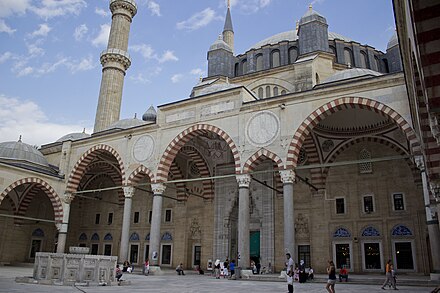
At about the age of fifty, he was appointed as chief royal architect for the Ottoman Empire, applying the technical skills he had acquired in the army to the "creation of fine religious buildings" and civic structures of all kinds, remaining in this post for almost fifty years. Sinan is said to have constructed or supervised 476 buildings (196 of which still survive), according to the official list of his works, the most famous and masterly built of which are, first and foremost the Selimiye mosque in Edirne, followed by the Imperial mosques and bathhouses in Istanbul, Damascus and Sofia. He lies in a tomb of his own design, in the cemetery just outside the walls of the Süleymaniye Mosque, across a street named Mimar Sinan Caddesi, in his honour.
Andrea Palladio
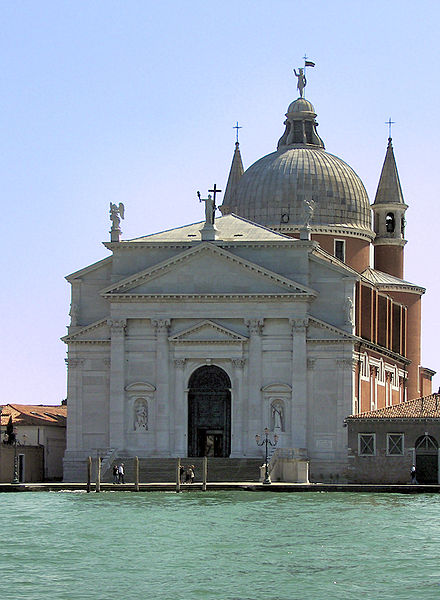 Born Andrea di Pietro della Gondola (1508-1580) in Padua, the son of a miller, he was apprenticed in Vicenza as a stonemason. His first rich patron had Greek and Roman aesthetic tastes, nicknamed him Palladio, "the wise one", sent him to Rome to sightsee and measure ruins, commissioned him for rebuilding work on his villa, and encouraged him to study Vitruvius and become a master architect. His next patron prepared a new edition of De Architectura and commissioned him to illustrate. Palladio's first book of his own was published in 1554, a Rome travel guide focused on its antiquities.
Born Andrea di Pietro della Gondola (1508-1580) in Padua, the son of a miller, he was apprenticed in Vicenza as a stonemason. His first rich patron had Greek and Roman aesthetic tastes, nicknamed him Palladio, "the wise one", sent him to Rome to sightsee and measure ruins, commissioned him for rebuilding work on his villa, and encouraged him to study Vitruvius and become a master architect. His next patron prepared a new edition of De Architectura and commissioned him to illustrate. Palladio's first book of his own was published in 1554, a Rome travel guide focused on its antiquities.
By this time, it was fashionable among the wealthy citizens of the Republic of Venice to purchase mainland property and build villas of luxury and comfort. For Palladio this trend became a prolific source of business and undying fame; 24 villas of his design are one together with 23 buildings in Vicenza. He became chief architect of the Most Serene Republic in 1570. In this capacity he designed the Redentore Church on Giudecca Island, maybe his most prominent masterpiece - to merely describe his contribution to the Venetian public landscape merits a long, very detailed on-foot-and-gondola itinerary article.
In the same year his Four Books of Architecture were published; later reprinted in many languages and widely circulated, the heavily illustrated seminal work cemented his reputation and influence. The Palladian style, elements and methods became the embodiment of rationality in the art of building, made the old "barbarous/Gothic/supertitious" architectural styles obsolete, and remained the prevalent face of Western architecture throughout the Enlightenment Age, well into the 19th century. In 2010, for the 500th anniversary of Palladio's birth, the US Congress passed Resolution 259 acknowledging his influence on Thomas Jefferson and later American architects.
Christopher Wren
.jpg/440px-St_Pauls_aerial_(cropped).jpg) Sir Christopher Wren (1632-1723) was a renaissance man, active in several fields of science and a Fellow of the Royal Society, but he is remembered mainly for his architecture.
Sir Christopher Wren (1632-1723) was a renaissance man, active in several fields of science and a Fellow of the Royal Society, but he is remembered mainly for his architecture.
After the great fire devastated London in 1666, he and associates in his office were the main architects for the rebuilding. Among other things, they designed 52 churches in the City of London alone. His best-known building is Saint Paul's cathedral in the center of that area; its crypt contains his grave.
There are many other Wren buildings, mainly in other parts of London but a few elsewhere in England and at least one in the US. The College of William and Mary in Virginia has a Wren Building; Thomas Jefferson was a student there.
Alfred Waterhouse
 Alfred Waterhouse (1830-1905) designed the Natural History Museum in London and several Grade II listed buildings in Manchester and Liverpool.
Alfred Waterhouse (1830-1905) designed the Natural History Museum in London and several Grade II listed buildings in Manchester and Liverpool.
One interesting aspect of his designs was his use of dual-purpose structures that both served required functions and acted as decorative visual elements. In the Natural History Museum, for example,the octagonal top storey of the towers contained the water tanks, and the four pinnacles surrounding the octagonal tower tops were the air intakes and exhaust vents for the museum's ventilation and heating system.
Antoni Gaudí
 Antoni Gaudí (1852-1926) was a Catalan architect who was the most famous exponent of the Modernisme architectural style that was in vogue in Catalonia during his lifetime. On 7 June 1926, while going to church, he was run down by a tramcar, and died three days later. Seven of his works in Barcelona have been listed as UNESCO World Heritage Sites, the most famous examples being Casa Milà aka "La Pedrera" residential building, La Sagrada Família church that had started on a neo-Gothic plan by someone else, has his tomb inside its crypt and is expected to be completed by the architect's death centenary in 2026, and Park Güell, which contains a house of his design with many clever personal design details, where he lived from 1906 until his death, when not inside his atelier at the Sagrada Família.
Antoni Gaudí (1852-1926) was a Catalan architect who was the most famous exponent of the Modernisme architectural style that was in vogue in Catalonia during his lifetime. On 7 June 1926, while going to church, he was run down by a tramcar, and died three days later. Seven of his works in Barcelona have been listed as UNESCO World Heritage Sites, the most famous examples being Casa Milà aka "La Pedrera" residential building, La Sagrada Família church that had started on a neo-Gothic plan by someone else, has his tomb inside its crypt and is expected to be completed by the architect's death centenary in 2026, and Park Güell, which contains a house of his design with many clever personal design details, where he lived from 1906 until his death, when not inside his atelier at the Sagrada Família.
Frank Lloyd Wright
See also: Architecture of Frank Lloyd Wright
Frank Lloyd Wright (1867-1959), during his career spanning more than 70 years, designed more than 1,000 buildings, about half of which were built. In 2019, eight of these buildings were listed as a world heritage site named The 20th-Century Architecture of Frank Lloyd Wright by UNESCO.
Wright was one of the leading lights of the "prairie school" of American architects. Two others were the Griffins who designed the Australian capital, Canberra. <br clear="right" />
Le Corbusier
 The Swiss-French architect Charles-Édouard Jeanneret-Gris (1887-1965) was better known under his artist name, Le Corbusier. Regarded as one of the fathers of modern architecture and urban planning, his buildings can today be seen in Europe, the Americas and Asia. His architecture and his views regarding how people should use his buildings remain controversial to this day and if you see his creations, you might get an idea why.
The Swiss-French architect Charles-Édouard Jeanneret-Gris (1887-1965) was better known under his artist name, Le Corbusier. Regarded as one of the fathers of modern architecture and urban planning, his buildings can today be seen in Europe, the Americas and Asia. His architecture and his views regarding how people should use his buildings remain controversial to this day and if you see his creations, you might get an idea why.
Some works of this architect are the planned city of Chandigarh, the Villa Savoye in Poissy outside Paris where he expressed his "five points of new architecture", the Immeuble Clarté in Geneva, the Centrosoyuz Building in Moscow, the Carpenter Center for the Visual Arts in Cambridge (Massachusetts), four "Unité d'habitation" apartment buildings around Europe which later served as inspiration for Brutalist architecture and many "villas" in France and Switzerland including his own cabin on the French Riviera where he spent the last years of his life.
In 2016, 17 of his creations were listed by UNESCO as a world heritage site named "The Architectural Work of Le Corbusier, an Outstanding Contribution to the Modern Movement". <br clear="right" />
Paul Williams
Paul Revere Williams (1894-1980) was an architect based in Los Angeles who designed over 2000 buildings in his career, including homes for Hollywood stars such as Frank Sinatra, Lucille Ball and Desi Arnez, and Lon Chaney. He was black and had to overcome considerable prejudice to succeed.
Luis Barragán
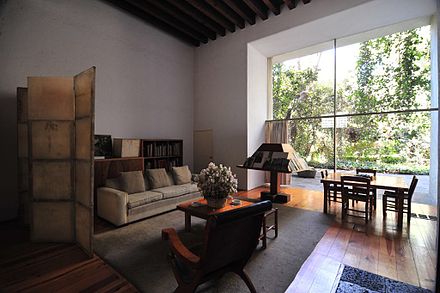 Mexico's most famous architect of the modern age is without question Luis Barragan (1902-1988). Barragan began his career in Guadalajara but spent most of his career in Mexico City, where he designed a number of public buildings as well as his own home and studio, which has been designated a . His style is unmistakably modernist with clean lines and a reliance on concrete as his primary construction medium. Unlike other modernists, Barragan rejected the functionist philosophy, instead believing that human values like beauty, intimacy, and serenity (among others) must be reflected in architecture. He would often achieve this by integrating nature with the built environment and with his bold use of color. Some of Barragan's most famous projects include the Torres de Satelite in Mexico City, Cuadra San Cristobal, and the Gardens of Pedregal. In Monterrey, Barragan is famous for designing the MARCO Museum and the Faro de Comercio in the city's Macroplaza. Barragan was awarded the Pritzker prize in 1980.
Mexico's most famous architect of the modern age is without question Luis Barragan (1902-1988). Barragan began his career in Guadalajara but spent most of his career in Mexico City, where he designed a number of public buildings as well as his own home and studio, which has been designated a . His style is unmistakably modernist with clean lines and a reliance on concrete as his primary construction medium. Unlike other modernists, Barragan rejected the functionist philosophy, instead believing that human values like beauty, intimacy, and serenity (among others) must be reflected in architecture. He would often achieve this by integrating nature with the built environment and with his bold use of color. Some of Barragan's most famous projects include the Torres de Satelite in Mexico City, Cuadra San Cristobal, and the Gardens of Pedregal. In Monterrey, Barragan is famous for designing the MARCO Museum and the Faro de Comercio in the city's Macroplaza. Barragan was awarded the Pritzker prize in 1980.
Oscar Niemeyer
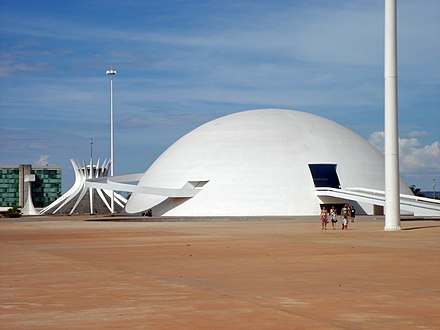 Brazilian architect Oscar Ribeiro de Almeida Niemeyer Soares Filho (1907 – 2012) is considered one of the key figures in the development of modern architecture. Strongly influenced by Le Corbusier, Niemeyer is best known for his design of civic buildings for Brasília, Brazil's planned capital city from 1960 on, and of Belo Horizonte's Pampulha Architectural Complex, now a world heritage site.
Brazilian architect Oscar Ribeiro de Almeida Niemeyer Soares Filho (1907 – 2012) is considered one of the key figures in the development of modern architecture. Strongly influenced by Le Corbusier, Niemeyer is best known for his design of civic buildings for Brasília, Brazil's planned capital city from 1960 on, and of Belo Horizonte's Pampulha Architectural Complex, now a world heritage site.
His collaboration with other architects on the United Nations Headquarters in New York City is widely praised as well. His exploration of the aesthetic possibilities of reinforced concrete was highly influential in the late 20th and early 21st centuries. Both lauded and criticized for being a "sculptor of monuments", Niemeyer is held as a great artist, and one of the greatest architects of his generation, by his supporters, and accused of a highly criticizable architecture, functionally and budget-wise, by his detractors. <br clear="right" />
I.M. Pei
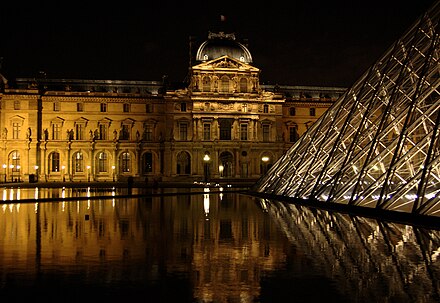 I.M. Pei (1917-2019) spent his early years in China, but moved to the USA for university and lived there most of his life. He designed buildings in many places and was very much a modern architect, heavily influenced by the European Bahaus school.
I.M. Pei (1917-2019) spent his early years in China, but moved to the USA for university and lived there most of his life. He designed buildings in many places and was very much a modern architect, heavily influenced by the European Bahaus school.
Pei designed a number of important public buildings including Dallas city hall, the National Center for Atmospheric Research in Boulder, and the Kennedy Library and the John Hancock Tower in Boston. He has also done commercial buildings, notably the Bank of China tower in Hong Kong.
Museums were a specialty; perhaps his best-known work is the controversial glass pyramid outside the Louvre in Paris. Other projects included the East Building of the National Gallery of Art in Washington, DC, an extension of the German Historical Museum in Berlin. the Rock and Roll Hall of Fame in Cleveland, the Museum of Islamic Art in Doha and the Miho Museum near Kyoto. He came out of retirement in his 80s to design a museum for the Chinese city of Suzhou where his family were from. <br clear="right" />
Frank Gehry
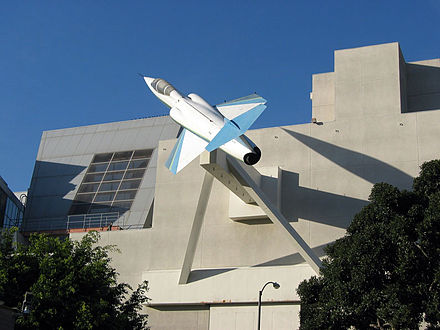 The Canadian-American architect Frank Gehry (1929-) is known for his Deconstructivist creations which include:
The Canadian-American architect Frank Gehry (1929-) is known for his Deconstructivist creations which include:
- Guggenheim Museum in Bilbao
- Dancing House in Prague
- Art Gallery of Ontario in Toronto
- MIT Ray and Maria Stata Center in Cambridge (Massachusetts)
- Walt Disney Concert Hall in downtown Los Angeles
- the Vontz Center for Molecular Studies on the University of Cincinnati campus
- New World Center in Miami Beach
- Weisman Art Museum in Minneapolis
- the California Science Center in Los Angeles.
Douglas Cardinal
Douglas Cardinal (1934-) is partly an Indigenous Canadian, having both Blackfoot and Mohawk ancestors. His best-known designs are museums:
- Canadian Museum of History, in Gatineau, Quebec, right across the river from Parliament Hill in Ottawa
- National Museum of the American Indian, on the National Mall in Washington DC
Meinhard von Gerkhan
(Born 1935 in Riga) probably one of the best known contemporary German architects, his designs include the Berlin Tegel airport, the Tempodrom in Berlin, expansions to the Stuttgart and Hamburg airports, as well as the new Berlin Hauptbahnhof main rail station. However, von Gerkhan has sued Deutsche Bahn over differences between the way the main station looks now and his original design. Similarly, Tegel could probably be both more impressive and more efficient had Gerkan's original double hexagon design been built, instead of the single hexagon and numerous uninspired additions that now characterize the airport. The architecture company von Gerkhan founded, gmp (short for "Gerkhan Marg & Partner"), is still active globally and is particularly renowned for their sports stadium designs.
Norman Foster
Norman Foster (born 1935 in Stockport) is an English architect, one of the leading exponents of British modernist architecture. Prominent buildings designed by him include the dome of Berlin's Bundestag, the HSBC Building and Terminal 1 of Hong Kong International Airport in Hong Kong, and 30 St Mary Axe, nicknamed "the Gherkin", in London.
Santiago Calatrava
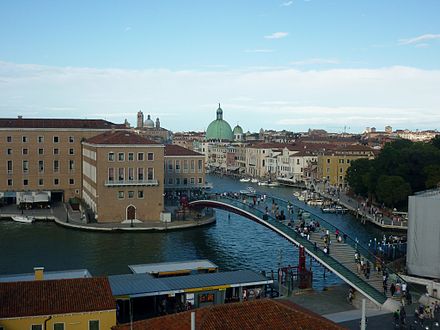
Skylines
Quite a few cities have famous skylines that are major draws for tourists. Skylines are not only due to architecture but also may include backdrops of mountains or bodies of water, and it helps when there are natural high places to view the entire skyline from and/or skyscrapers from which one can see at least part of the view. Some cities famously include more than one skyline. Here is some information about skylines that are famous and beautiful.
Asia
- Jerusalem has a famous skyline, holy to several religions. It is well-known as a hilly city, so go to the top of a hill in eastern Jerusalem for a view of the Old City and New Jerusalem beyond.
- Hong Kong has a famous modern skyline, and it's also geographically beautiful. Go to the top of Victoria Peak to see a great panorama of Hong Kong Island and Kowloon beyond. Alternatively, you can see a great view looking up from Victoria Harbour, such as by taking the Star Ferry between Hong Kong and Kowloon. Most evenings there is "A Symphony of Lights" when about 40 buildings are illuminated for a light show, best viewed from Kowloon waterfront.
- Shanghai's most famous skyline is the modern one in Pudong, though it also still has remnants of an Art Deco waterfront in the Bund on the other side of the Huangpu River. You can see both sides by taking a river cruise, or walk on the Bund side and then go to a high floor of one of the skyscrapers in Pudong.
Europe
-
Florence has a famous, beautiful skyline that is best seen from the steps of San Miniato al Monte or the Piazzale Michelangelo slightly down the hill from that church, or from the top of the Boboli Gardens. Alternatively, you can see a more distant view from Fiesole, but it might be marred by smog.
-
From within London, you're unlikely to get a better view than from the top of the London Eye, so if you're an architecture enthusiast, it's worth paying for a ride. The eye is centrally located, so you'll have a good view of all the newer skyscrapers in the City of London, Canary Wharf and anywhere else along and some distance from the Thames.
-
Favorite places from which to see the Paris skyline include the church of Sacré Coeur in Montmartre and the Tour de Montparnasse - partly, as some cynical Parisians would say, because the views don't include Sacré Coeur or the Tour de Montparnasse. Sacré Coeur is above and to the north of the rest of Paris, so you can view the whole city from there, whereas the Tour de Montparnasse is right in the center of a major commercial district, so you have a 360° view that is close to some of the sights. The view from the top of the Arc de Triomphe is also famous, as you get to look down each one of the streets that converge on the Place Charles de Gaulle (formerly Place de l'Étoile).
North America
-
Chicago is a geographically virtually flat city, but its architecture is so famous that architectural tours are considered a must for visitors by many Chicagoans. These tours usually take place on branches of the Chicago River, from where you can see changing vistas and buildings from different eras. A walk up Michigan Avenue or State Street through the Loop, across a bridge and through the Near North Side will also introduce you to many beautiful structures.
-
New York City has several skylines, but most famously, Downtown and Midtown Manhattan. The best locations from which to see both skylines include the New Jersey cities of Jersey City, Weehawken and Hoboken, the pedestrian path over the Brooklyn Bridge, and for a distant view that's particularly beautiful at sundown, the George Washington Bridge. The East Side has more classic Art Deco buildings than the West Side in Midtown, and for great views of that skyline, a trip to Roosevelt Island on the tram and a walk on the path on the part of the island facing Manhattan is ideal. For views of Downtown from the east, East River Park in Brooklyn and the Promenade in Brooklyn Heights are excellent. A unique, great view of the Downtown and Jersey City skylines can be had by taking the Staten Island Ferry, which is free.
-
Downtown Philadelphia has a beautiful skyline, graced by the neo-Art Deco skyscrapers of Liberty Place. The Benjamin Franklin Bridge is a good place from where to view it.
-
San Francisco's skyline is famous, but the city is notoriously foggy. On a clear day, you can have a great view from Twin Peaks, accessible by car or bus (or by bicycle or foot if you are ambitious). There are various other hills you can visit, but Twin Peaks is the highest in the city, so you can see the furthest from there when there is no fog. Bring warm clothing, as it's always windy up there.
South America
- Rio de Janeiro sits on the most spectacular geographical location on the planet. As the song says, "Rio, the mountain, the sky, the sea. Rio that I'll always love". Mountain lookouts like Vista Chinesa and Paineiras have iconic views that for Brazilians have become commonplace because of massive media overexposure.
- Porto Alegre by the Guaíba estuary is home to nice public architecture of many periods and gorgeous sunsets, better appreciated from riverside or the famous TV Hill.
- Brasília features a truly unique skyline of Modernist and Brutalist architecture, with many green open spaces. Famous viewpoints include the centrally located old TV Tower, the new Digital TV Tower on the northern edge of the city, and the iconic Ermida Dom Bosco.
- Belo Horizonte, the planned capital of Minas Gerais state, innaugurated in 1897, was once (aptly) named "King's Corral", as it sits in the middle of a round big valley surrounded by cliffs. There are many viewpoints on them, above the big city and its nice urban planning. About 120 km away, the old capital Ouro Preto, a colonial mining city built on a very uneven mountain landscape, has a totally different skyline experience altogether.
Record-holding structures
Building the tallest building in the world is every architect's dream (or perhaps nightmare) project, as it will eventually be topped by an even taller structure. See the Chicago skyline guide for information on the many tall buildings in Chicago, the birthplace of the skyscraper.
Tallest buildings
The following buildings, all over 350 meters, were each at one time the tallest building in the world.
- Burj Khalifa, Downtown Dubai, Dubai, UAE (built 2010) 160 storeys
- Taipei 101, Xinyi District, Taipei, Taiwan (built 2004) 101 storeys
- Petronas Towers, Golden Triangle, Kuala Lumpur, Malaysia (built 1998) 88 storeys
- Sears Tower, the Loop, Chicago, USA (built 1974) 110 storeys
- Empire State Building, Midtown, Manhattan, New York, USA (built 1931) 102 storeys
This is the current (as of 2021) list of the ten tallest buildings in the world. The rankings depend on how exactly you define "tallest" and "building", so different sources give slightly different lists, but everyone agrees that the Burj Khalifa is the tallest by far.
- Burj Khalifa, Downtown Dubai, Dubai, UAE (built 2010) 160 storeys 828 m
- Shanghai Tower, Pudong, Shanghai, China (built 2015) 128 storeys 632 m
- Abraj Al Bait Clock Tower, Mecca, Saudi Arabia (built 2012) 120 storeys 601 m
- Ping An Finance Centre, Futian, Shenzhen, China (built 2017) 118 storeys 599 m
- Lotte World Tower, Songpa, Seoul, South Korea (built 2016) 123 storeys 554.5 m
- One World Trade Center, Financial District, Manhattan, New York City, United States (built 2014) 104 storeys 541.3 m
- (tied) Guangzhou CTF Finance Centre, Tianhe District, Guangzhou, China (built 2016) 111 storeys 530 m
- (tied) Tianjin CTF Finance Centre, Tianjin, China (under construction) 98 storeys 530 m
- China Zun, Chaoyang District, Beijing, China (under construction) 108 storeys 528 m
- Taipei 101, Xinyi District, Taipei, Taiwan (built 2004) 101 storeys 509 m
The Marina area of Dubai had seven of the world's ten tallest residential buildings as of 2010.
The number eight is considered lucky in much of East Asia and hence this number is often deliberately chosen for things like number of floors.
Tallest towers
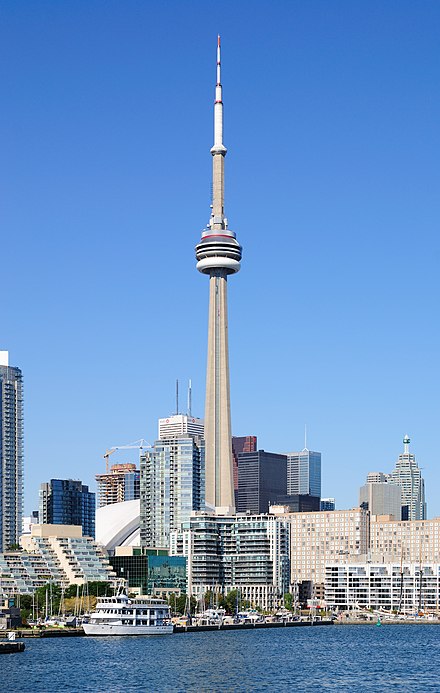 These towers, all over 300 meters (about 1000 feet), were each at one time the tallest tower in the world.
These towers, all over 300 meters (about 1000 feet), were each at one time the tallest tower in the world.
- Tokyo Skytree, Sumida, Tokyo, Japan (built 2012) 634 m
- Canton Tower, Haizhu, Guangzhou, China (built 2010) 604 m
- CN Tower, Downtown Toronto, Canada (built 1976) 553 m
- Ostankino Tower, outskirts of Moscow, Russia (built 1967) 540 m
- Tokyo Tower, Minato, Tokyo, Japan (built 1958) 333 meters
- Eiffel Tower, 7th arrondissement, Paris, France (built 1889) 300 m when built, 324 m with TV antenna.
This is the current (2018) list of the ten tallest towers in the world.
- Tokyo Skytree, Sumida, Tokyo, Japan (built 2012) 634 m
- Canton Tower, Haizhu, Guangzhou, China (built 2010) 604 m
- CN Tower, Downtown Toronto, Canada (built 1976) 553 m
- Ostankino Tower, outskirts of Moscow, Russia (built 1967) 540 m
- Oriental Pearl Tower, Pudong, Shanghai, China (built 1995) 468 m
- Milad Tower, Tehran, Iran (built 2007) 435 m
- KL Tower, Golden Triangle, Kuala Lumpur, Malaysia (built 1994) 421 m
- Tianjin Radio and Television Tower, Tianjin, China (built 1991) 415 m
- Central Radio and TV Tower, Haidian District, Beijing, China (built 1992) 405 m
- Zhongyuan Tower, Zhengzhou, China (built 2011) 388 m
Sky Tower in Auckland, New Zealand (built 1997) at 328 m is the tallest in the Southern Hemisphere.
In the USA and Poland there are some guyed radio masts that are taller than some of the items on this list. After the Burj Khalifa, the tallest construction built so far is the Warsaw radio mast near Gabin.
Other records
See also: Developmental records
Of course, height is not the only way in which a building might be remarkable. Other records include:
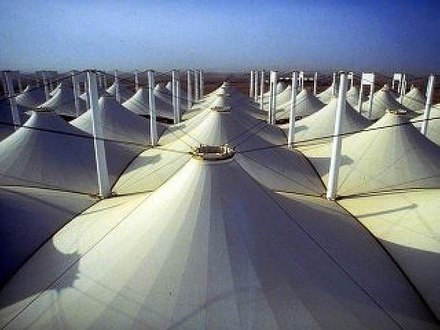
- Edificio Copan in São Paulo is "only" 38 stories, but it has 1160 apartments and is considered the world's largest residential building by floor area
- Largest buildings by roof area: the two Hajj terminals at Jeddah airport, which each handle dozens of large aircraft carrying Muslim pilgrims.
- Longest structure on Earth: the Great Wall of China is several thousand km. It is arguably not really all one structure, different parts having been built by different dynasties centuries apart, but even those parts are enormous.
- Depending on how you define "structure" the great Dingo-fence that crosses Australia is even larger than the great wall of China Several industrial buildings are huge due to the nature of the work done there. Examples include:
- The former Cargolifter hall in Brandenburg, which has the biggest single span roof in the world and was designed to hold a Zeppelin that never was and now houses a tropical themed water amusement park
- The Meyer Werft in Papenburg, Lower Saxony where cruise ships are built (tour possible). It is by far the biggest dry dock and one of the biggest buildings in the world.
- The Boeing factory in Everett, Washington - the biggest man made structure by interior volume
Unusual buildings

- The Leaning Tower of Pisa is often considered unusual, though a pagoda in Suzhou has been called the "leaning tower of China" and there are other less famous leaning towers in various countries, including several elsewhere in Italy.
- Prora on the Baltic Sea has a hotel for 20,000 workers on holiday, created by the Nazi regime in Germany, never used for its intended purpose, never completed, later used as barracks by the GDR, and now housing a museum as well as accommodation while being mostly empty
- The Hakka Tulou of southern China are mostly-earth easily-defended buildings, home to entire clans of a few hundred people
- The diaolou (castles) of Kaiping are fanciful houses built by overseas Chinese, mostly in the early 20th century
